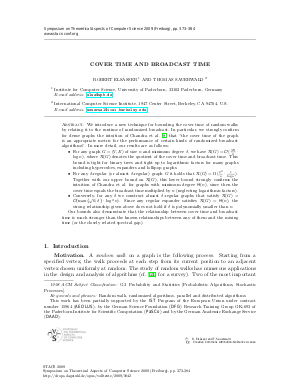Cover Time and Broadcast Time
Authors Robert Elsässer, Thomas Sauerwald
-
Part of:
Volume:
26th International Symposium on Theoretical Aspects of Computer Science (STACS 2009)
Part of: Series: Leibniz International Proceedings in Informatics (LIPIcs)
Part of: Conference: Symposium on Theoretical Aspects of Computer Science (STACS) - License:
 Creative Commons Attribution-NoDerivs 3.0 Unported license
Creative Commons Attribution-NoDerivs 3.0 Unported license
- Publication Date: 2009-02-19
File

PDF
LIPIcs.STACS.2009.1842.pdf
- Filesize: 241 kB
- 12 pages
Document Identifiers
Subject Classification
Keywords
- Random walk
- Randomized algorithms
- Parallel and distributed algorithms
Metrics
- Access Statistics
-
Total Accesses (updated on a weekly basis)
0Document
0Metadata
Abstract
We introduce a new technique for bounding the cover time of random walks by relating it to the runtime of randomized broadcast. In particular, we strongly confirm for dense graphs the intuition of Chandra et al. (1997) that ``the cover time of the graph is an appropriate metric for the performance of certain kinds of randomized broadcast algorithms''. In more detail, our results are as follows:
\begin{itemize}
\item For any graph $G=(V,E)$ of size $n$ and minimum degree $\delta$, we have $\mathcal{R}(G)= \mathcal{O}(\frac{|E|}{\delta} \cdot \log n)$, where $\mathcal{R}(G)$ denotes the quotient of the cover time and broadcast time. This bound is tight for binary trees and tight up to logarithmic factors for many graphs including hypercubes, expanders and lollipop graphs.
\item For any $\delta$-regular (or almost $\delta$-regular) graph $G$ it holds that $\mathcal{R}(G) = \Omega(\frac{\delta^2}{n} \cdot \frac{1}{\log n})$. Together with our upper bound on $\mathcal{R}(G)$, this lower bound strongly confirms the intuition of Chandra et al.~for graphs with minimum degree $\Theta(n)$, since then the cover time equals the broadcast time multiplied by $n$ (neglecting logarithmic factors).
\item Conversely, for any $\delta$ we construct almost $\delta$-regular graphs that satisfy $\mathcal{R}(G) = \mathcal{O}(\max \{ \sqrt{n},\delta \} \cdot \log^2 n)$. Since any regular expander satisfies $\mathcal{R}(G) = \Theta(n)$, the strong relationship given above does not hold if $\delta$ is polynomially smaller than $n$.
\end{itemize}
Our bounds also demonstrate that the relationship between cover time and broadcast time is much stronger than the known relationships between any of them and the mixing time (or the closely related spectral gap).
Cite As Get BibTex
Robert Elsässer and Thomas Sauerwald. Cover Time and Broadcast Time. In 26th International Symposium on Theoretical Aspects of Computer Science. Leibniz International Proceedings in Informatics (LIPIcs), Volume 3, pp. 373-384, Schloss Dagstuhl – Leibniz-Zentrum für Informatik (2009)
https://doi.org/10.4230/LIPIcs.STACS.2009.1842
BibTex
@InProceedings{elsasser_et_al:LIPIcs.STACS.2009.1842,
author = {Els\"{a}sser, Robert and Sauerwald, Thomas},
title = {{Cover Time and Broadcast Time}},
booktitle = {26th International Symposium on Theoretical Aspects of Computer Science},
pages = {373--384},
series = {Leibniz International Proceedings in Informatics (LIPIcs)},
ISBN = {978-3-939897-09-5},
ISSN = {1868-8969},
year = {2009},
volume = {3},
editor = {Albers, Susanne and Marion, Jean-Yves},
publisher = {Schloss Dagstuhl -- Leibniz-Zentrum f{\"u}r Informatik},
address = {Dagstuhl, Germany},
URL = {https://drops.dagstuhl.de/entities/document/10.4230/LIPIcs.STACS.2009.1842},
URN = {urn:nbn:de:0030-drops-18421},
doi = {10.4230/LIPIcs.STACS.2009.1842},
annote = {Keywords: Random walk, Randomized algorithms, Parallel and distributed algorithms}
}
